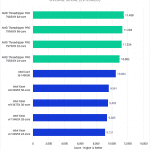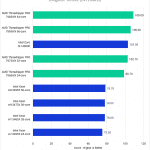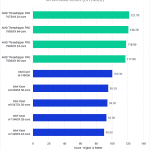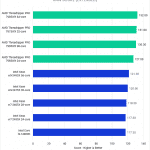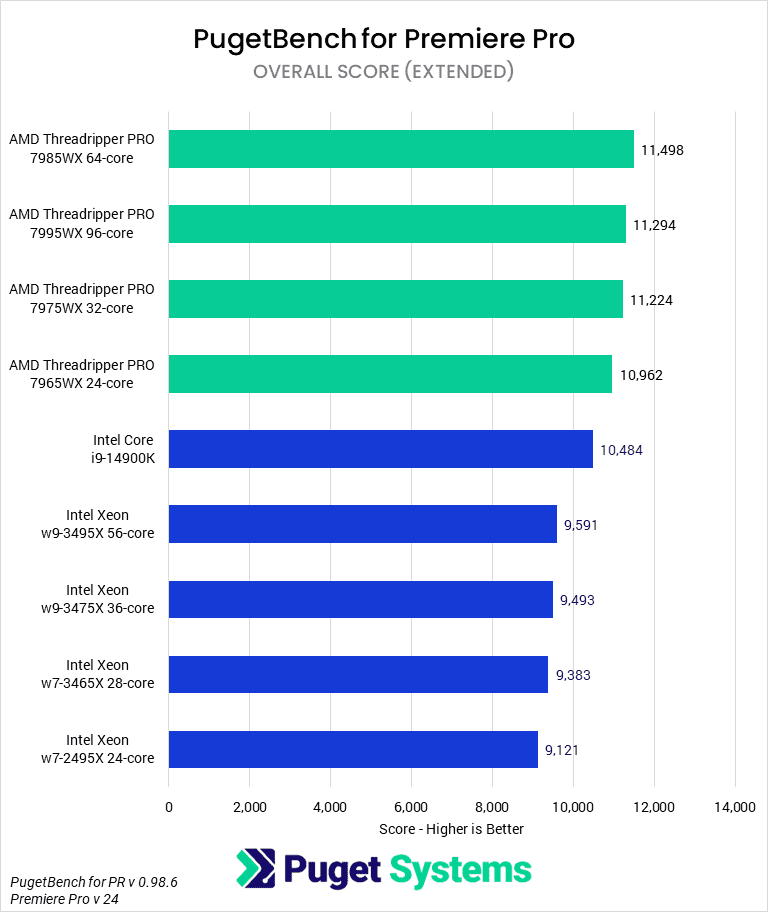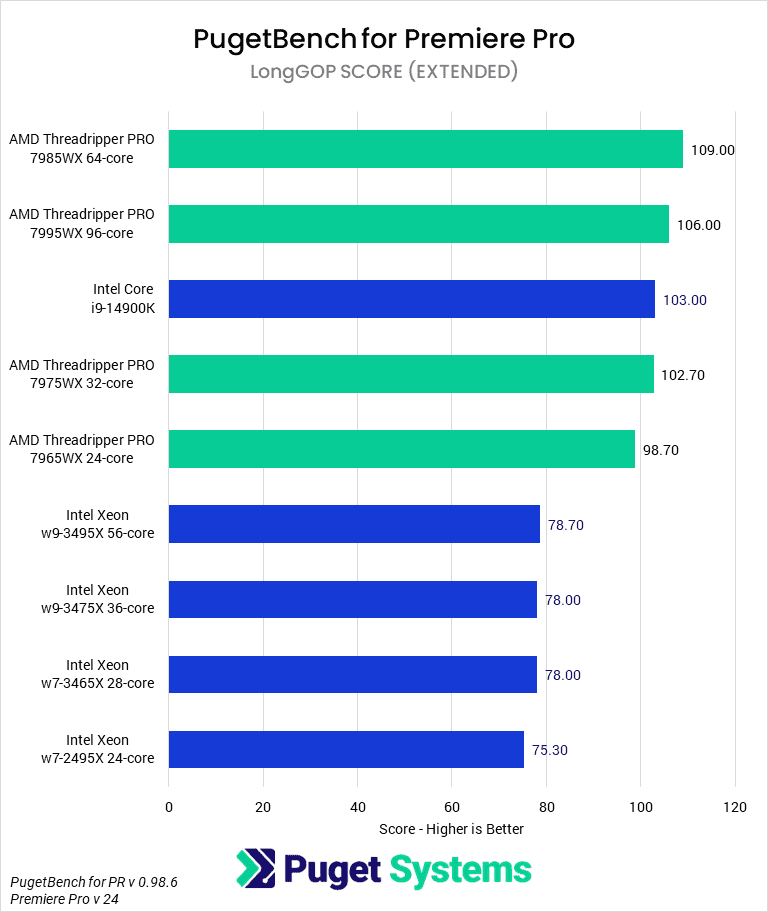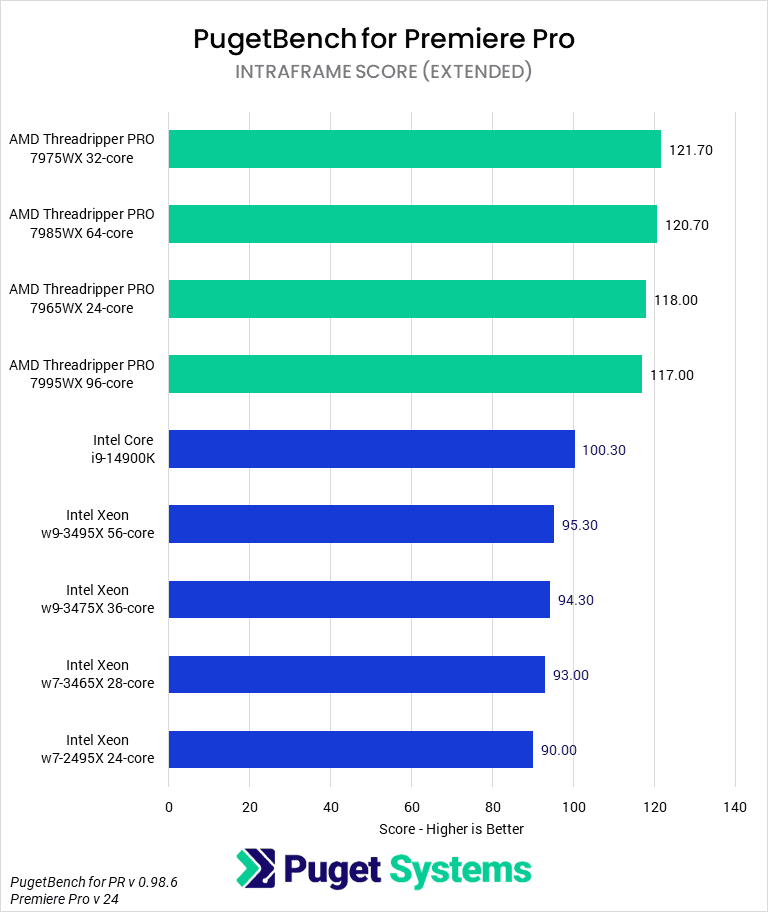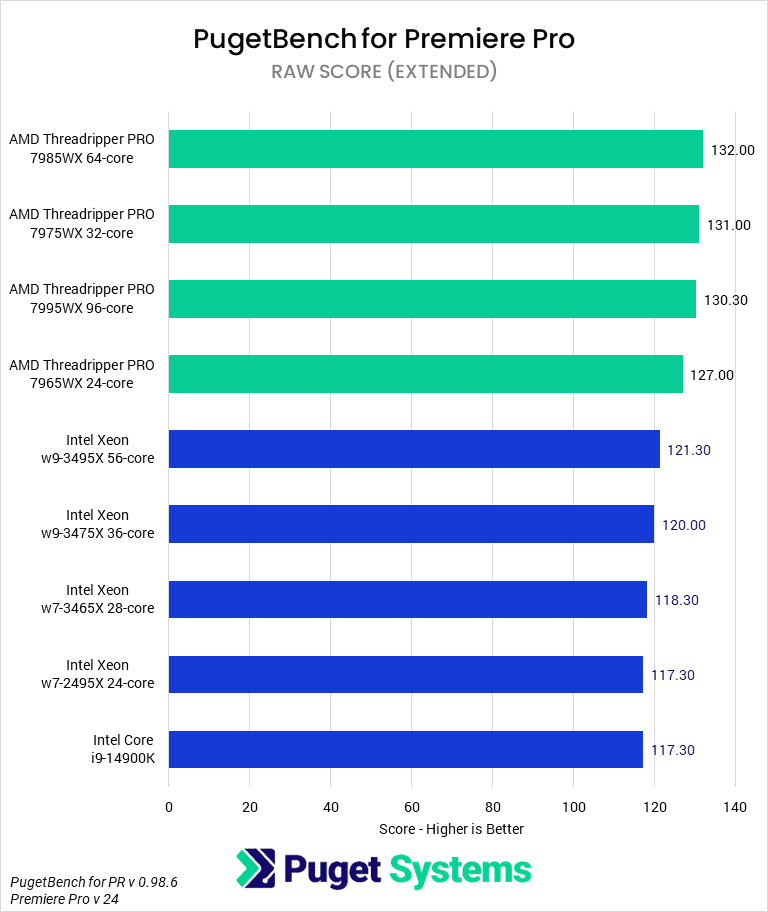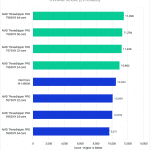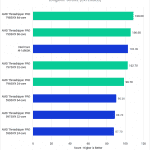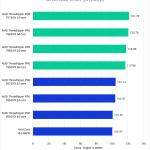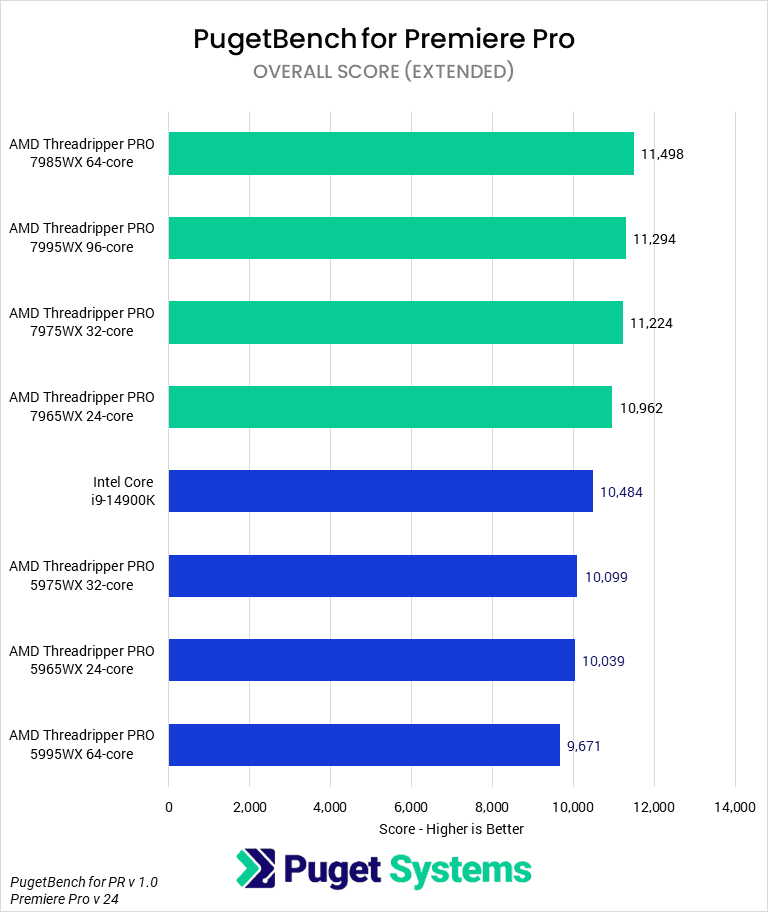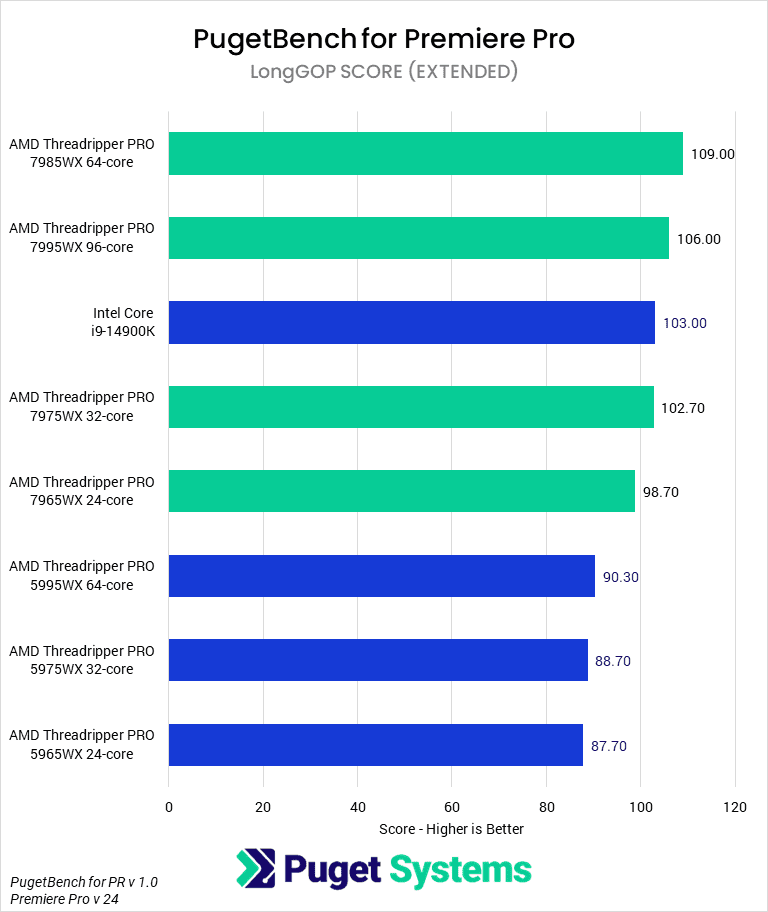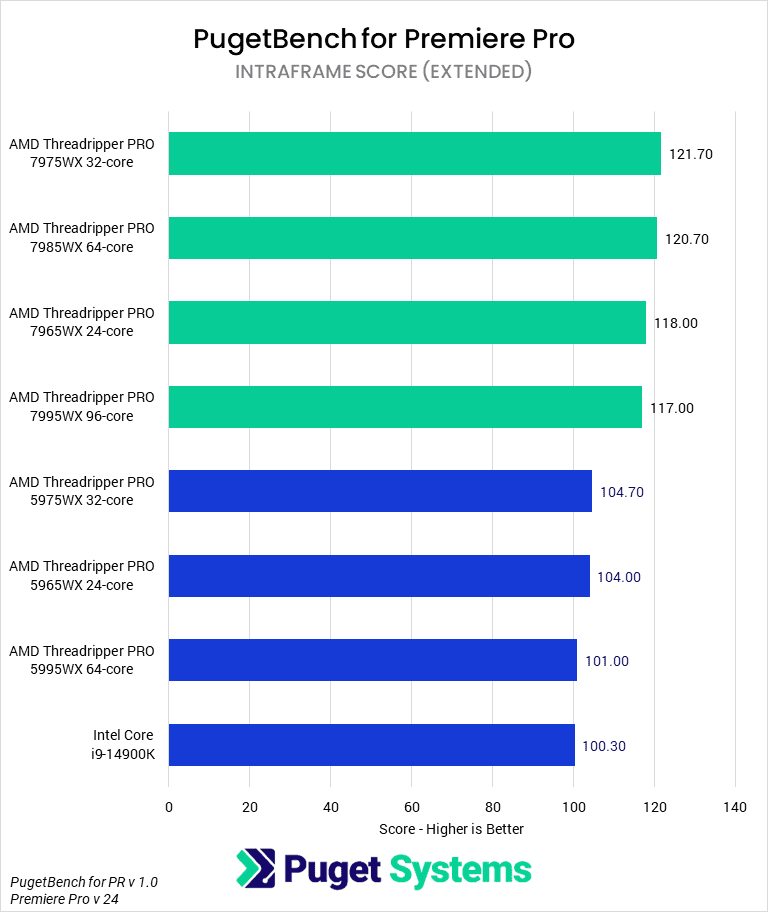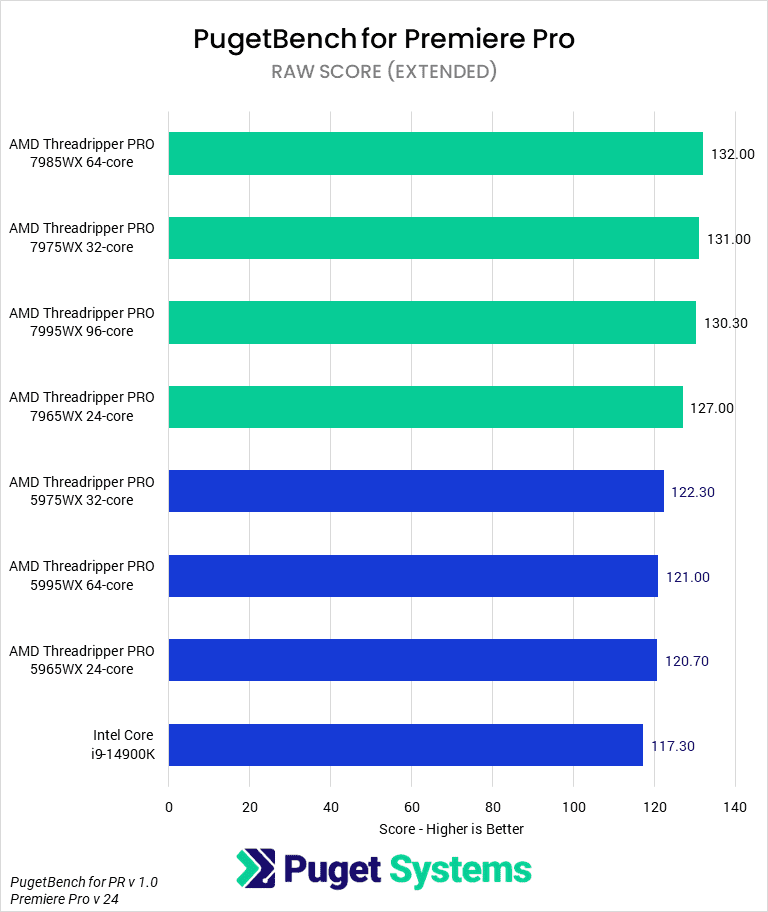Table of Contents
TL;DR: AMD Threadripper PRO 7000 WX-Series Performance in Premiere Pro
Unlike other applications we tested like Adobe After Effects where the gen-to-gen performance gain is very impressive, for Premiere Pro, the new AMD Threadripper PRO 7000WX processors are only around 10% faster than the previous generation Threadripper PRO 5000WX. Although this is fairly modest, they are still solidly faster than any Intel Xeon W CPU currently on the market. Based on Xeon CPUs of a similar MSRP, you can expect the new Threadripper PRO 7000WX models to be around 20% faster than Intel overall.
Introduction
With their “7000” series of processors, AMD is once again splitting their high core-count CPUs into two separate product families: the High-End Desktop (HEDT) AMD Ryzen Threadripper 7000 Series, and the even higher tier AMD Ryzen Threadripper PRO 7000 WX-Series processors. Both are based on AMD’s Zen 4 architecture, which means they now support new technologies like PCI-e Gen 5.0 and DDR5 memory, but the “PRO” line includes twice the number of memory lanes (8 channel vs 4 channel) and more than twice the number of PCIe lanes (128 vs 48). In addition, the PRO line also includes a 96-core processor for those workloads that benefit from having a massive number of CPU cores.
We recently reviewed the Threadripper 7000 line in a range of Content Creation workflows, comparing them to the equivalent Intel Xeon W-3400 processors and found that the new Threadripper processors placed AMD in the lead over Intel in every content creation workload we tested. Today, we are going to bump it up a notch and take a look at how the AMD Threadripper PRO 7000 WX-Series performs in Adobe Premiere Pro.
We will note that for Premiere Pro, the additional features and benefits of the PRO series are not particularly useful. The extra PCI-e lanes are only a benefit if you plan to use more than three GPUs (or other x16 PCIe devices), which is rarely a concern for Adobe-based workflows. Similarly, the additional memory channels are mostly beneficial in memory-bound workflows, which most content creation applications are not.
If you want to see exactly where (and by how much) it may make sense to invest in the PRO line, we have a dedicated AMD Threadripper 7000 vs AMD Threadripper PRO 7000WX for Content Creation article. But in this article, we want to focus on the performance of the Threadripper PRO 7000 WX-Series compared to the previous generation Threadripper PRO 5000WX and the Intel Xeon W-2400/3400 line. In addition to Threadripper PRO and Xeon, we will also include the Intel Core 14900K to provide some context for how AMD Threadripper PRO compares to a more typical CPU choice for this type of workload. This is especially important for video editing, as the 14900K includes Intel Quick Sync, which can provide a performance boost for H.264 and HEVC media compared to using your GPU to process that type of codec.
Because there are so many CPUs to examine, we will break our analysis down into Intel vs AMD (AMD Threadripper PRO 7000WX vs Intel Xeon W-3400) and performance versus the previous generation (AMD Threadripper PRO 7000WX vs AMD Threadripper PRO 5000WX)
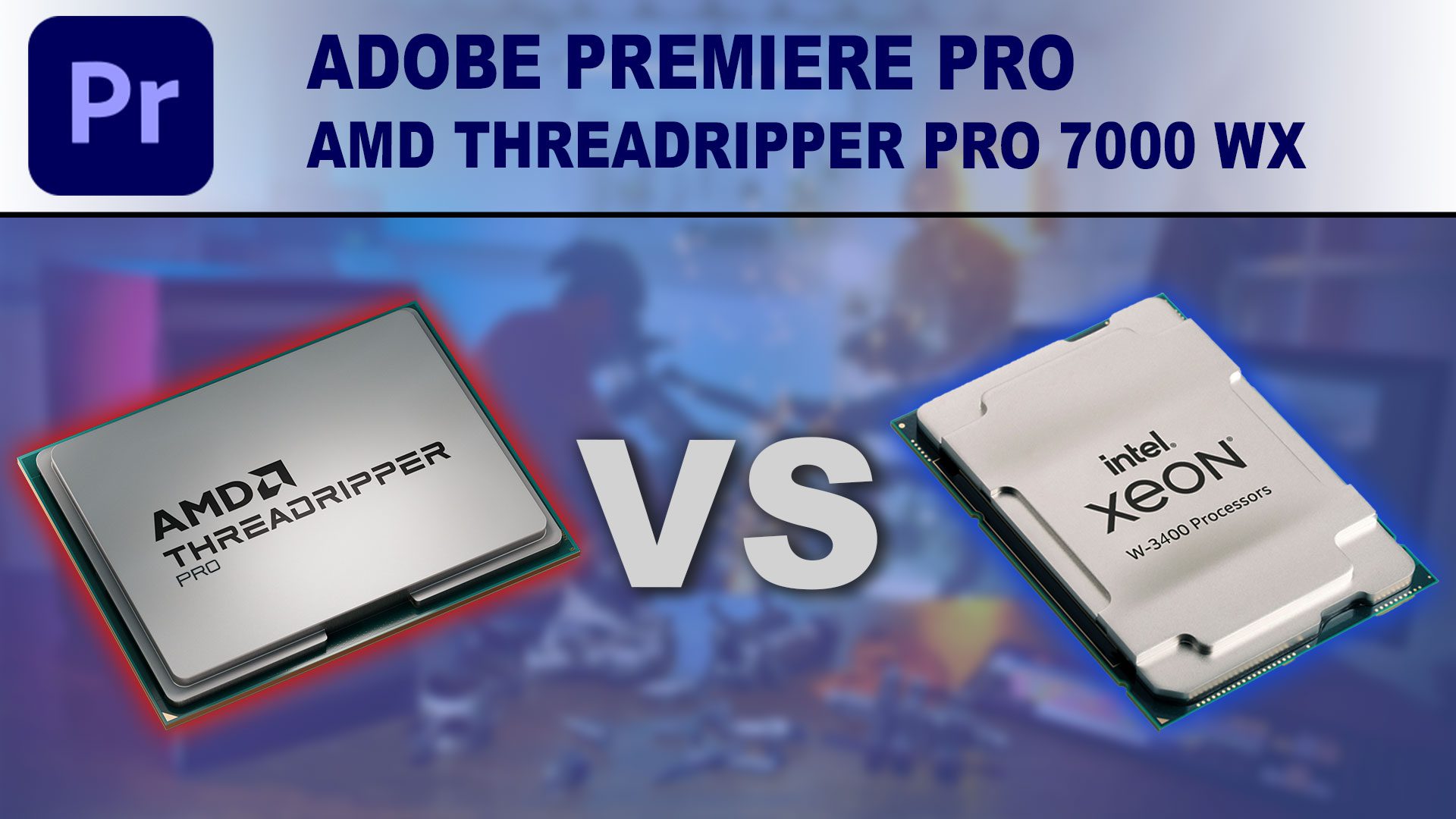
To learn more about how the new AMD Ryzen Threadripper PRO 7000 WX-Series processors perform in other workflows, we have compiled an overview in our AMD Ryzen Threadripper PRO 7000WX Content Creation Review article. That post also includes more detailed information on the CPU specifications and test results for various applications: Photoshop, Lightroom Classic, DaVinci Resolve, After Effects, Unreal Engine, Cinema 4D, Blender, and V-Ray.
In addition, although all the new AMD CPUs have a TDP of 350 W, TDP is rarely the whole story. To see how much power these chips use to complete tasks, check out our Power Analysis: AMD Ryzen Threadripper 7000 article. That is specifically looking at the non-Pro models, but both Threadripper lines have the same power draw and can be considered interchangeable when it comes to CPU power draw and cooling.
Raw Benchmark Data
We design our benchmarks to cover many workflows and tasks to provide a balanced look at the application and its hardware interactions. However, many users have more specialized workflows. Recognizing this, we like to provide individual results for benchmarks as well. If a specific area comprises most of your work, examining those results will give a more accurate understanding of the performance disparities between components.
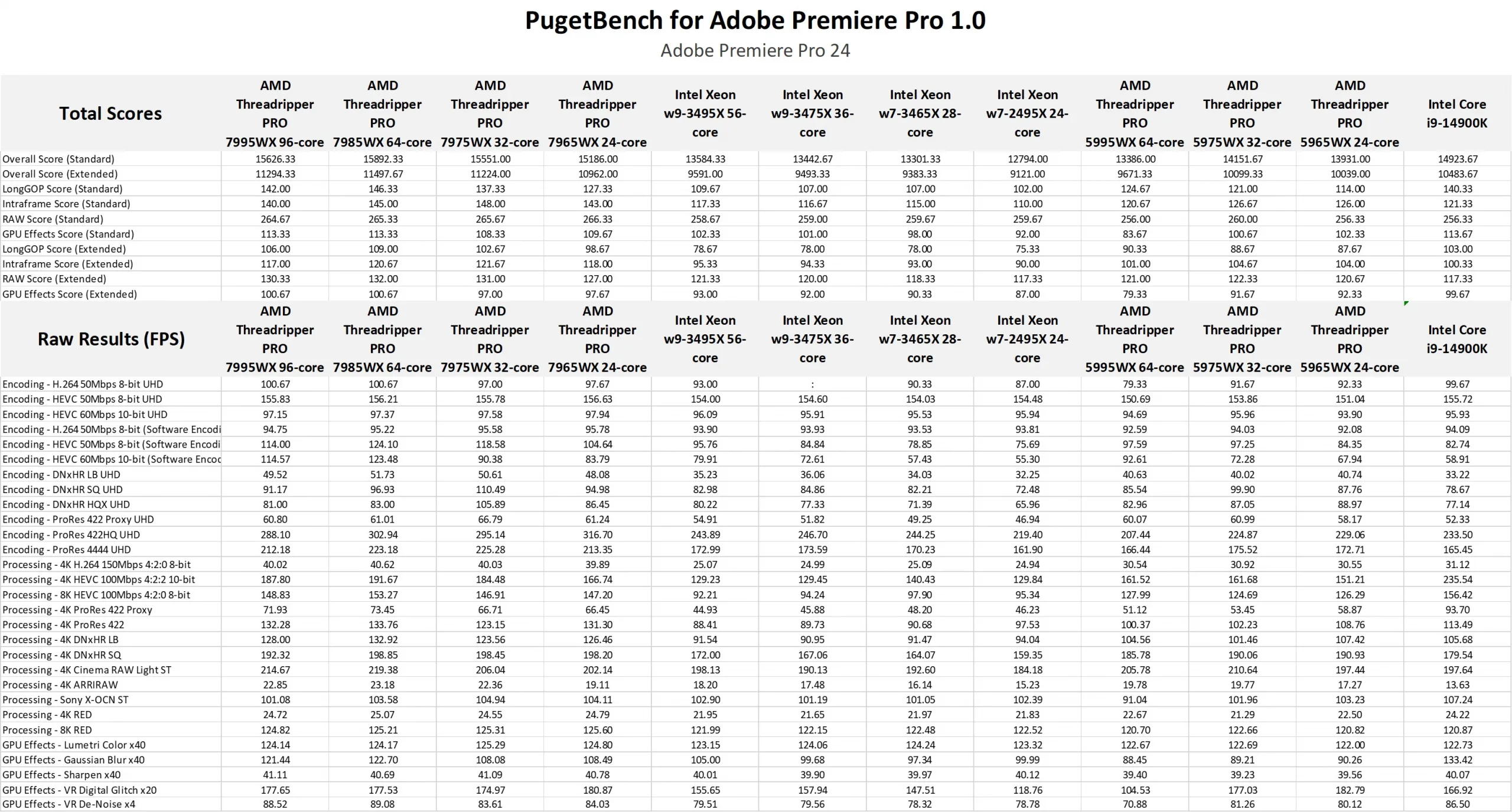
AMD Threadripper PRO 7000WX vs Intel Xeon W-3400 for Adobe Premiere Pro
Video Editing applications like Premiere Pro are some of the most complex workflows we look at for CPU performance, as the best CPU depends on the type of media you are working with. LongGOP codecs like H.264 and HEVC (chart #2) are among the most commonly used and are a bit unique in that the hardware decoding and encoding capabilities of your system are often more important than the raw power of your CPU. Something as powerful as Threadripper PRO can brute force their way through some things, but for specific flavors like HEVC 4:2:2 10-bit, there is no replacement for technology like Intel Quick Sync (found on the Intel Core family) that can be used for hardware decoding.
On the other hand, Intraframe codecs (chart #3) like ProRes and DNxHR are purely CPU-based. These are also among the easiest to work with, however, so a CPU with a lower benchmark score is often still well beyond the “good enough” level for most users. Lastly, RAW codecs (chart #4) like RED, ARRIRAW, and X-OCN are a mixed bag in how they use your system but often benefit from having a combination of both a powerful CPU and a powerful GPU. With that explained, we will focus on how the new AMD Threadripper PRO 7000 WX-Series compares to the Intel Xeon W-3400 line from an overall perspective. If you typically work with a specific codec type, however, we recommend focusing on that chart.
Right away, you can tell that the new AMD Threadripper PRO 7000WX line does very well, with even the 7965WX 24-core scoring above the fastest Intel Xeon W processor. We do want to point out that the Intel Core i9-14900K is only a few percent behind, largely due to its terrific performance for H.264 and HEVC codecs. For heavier (or CPU-bound) codecs like RED and Sony X-OCN, the 14900K doesn’t keep up as well, and Threadripper PRO will be more beneficial.
Interestingly, Premiere Pro doesn’t scale particularly well with extremely high core counts, with the Threadripper PRO 7995WX 96-core scoring only a few percent higher than the 7965WX 24-core. Luckily, having more cores doesn’t seem to hurt performance like we saw in our Photoshop testing, but in most cases, there is little reason to invest in more than the 24-core model unless you want additional headroom for multitasking.
Still, even without much in the way of multi-core scaling, the new Threadripper PRO 7000 WX-Series is around 20% faster than a comparable Intel Xeon W-3400 processor. Although, we will admit that a price-to-performance comparison gets difficult once you get up to the 7985WX 64-core and 7995WX 96-core simply because there is no Intel CPU at those price points.
AMD Threadripper PRO 7000WX vs AMD Threadripper PRO 5000WX for Adobe Premiere Pro
When comparing the new AMD Threadripper PRO 7000WX CPUs to the previous generation, you need to be aware that AMD introduced a price increase in this generation. The exact amount varies, but ranges from $250 with the 24-core models, to $600 with the 32-core, and $850 with the 64-core. In addition, the 96-core is priced well above anything from the previous generation – coming in at a staggering $10,000 for the CPU by itself. Even with this price increase, a core-to-core comparison is the closest we can do from a price perspective; just keep in mind that the gen-to-gen performance gain needs to be enough to also overcome the price increases with this generation.
Something else to note is that while we didn’t see much performance degradation with the new processors once we crossed the 32-core barrier like we did in Photoshop and a few other applications, that is not true for the previous generation. It isn’t by much, but the Threadripper PRO 5995WX 64-core scored about 4% lower than the 5975WX 32-core. This somewhat inflates the gen-over-gen performance gain of the new Threadripper PRO 7985WX 64-core in particular, which is about 19% faster than the 5995WX 64-core, but only 10% faster than the 5975WX 32-core.
If we ignore the 5995WX as an exception, the gen-over-gen performance for the new Threadripper PRO 7000 WX-Series is right around 10% across the board. This isn’t as much as we see in our testing for other applications like Adobe After Effects, but it at least largely covers the price increase AMD introduced with this generation of Threadripper PRO.
How Well Do the AMD Threadripper PRO 7000WX CPUs Perform in Premiere Pro?
Unlike other applications we tested, like Adobe After Effects, where the gen-over-gen performance gain is very impressive, for Premiere Pro, the new AMD Threadripper PRO 7000WX processors are only around 10% faster than the previous generation Threadripper PRO 5000WX. The Threadripper PRO 7985WX 64-core and 7995WX 96-core are a bit of an exception as they out-scored the 5995WX 64-core by about 20%, but the 5995WX is slower than the 5975WX so it is a bit unfair of a comparison.
Although the performance gains are fairly modest in Premiere Pro, the new Threadripper PRO 7000 WX-Series are still solidly faster than any Intel Xeon W CPU currently on the market. Based on Xeon CPUs of a similar MSRP, you can expect the new Threadripper PRO models to be around 20% faster than Intel overall.
It is worth noting that even though Threadripper PRO 7000WX does well in Premiere Pro, they may not be the best choice for every workflow. First, if you primarily use H.264 or HEVC codecs, an Intel Core 14th Gen processor may be a better choice due to the hardware decoding capabilities of Intel Quick Sync. Second, the additional feature set of Threadripper PRO (8-channel RAM, 128 PCIe lanes, and the 96-core model) does not benefit Premiere Pro much and only results in a few percent higher performance than the more affordable Threadripper 7000 line. If you want a deeper dive around whether the PRO line is worth the investment, we have a dedicated AMD Threadripper 7000 vs AMD Threadripper PRO 7000WX for Content Creation article we recommend checking out.
But, if your overall workflow can benefit from investing in Threadripper PRO, it is a fact that the new 7000 WX-Series are the fastest processors we have tested to date. Just remember that every application uniquely utilizes hardware, so our results here don’t necessarily translate to any other application. Our focus in this article centers specifically on Threadripper PRO 7000 WX-Series performance in Adobe Premiere Pro. If you use other applications as well, we recommend checking out our AMD Ryzen Threadripper PRO 7000 WX-Series Content Creation Review article, which includes a broad overview of results for several different applications. If you use other software packages, it also has links to our in-depth testing articles for content creation: Lightroom Classic, Photoshop, After Effects, DaVinci Resolve, Unreal Engine, Cinema 4D, Blender, and V-Ray.
Finding the perfect workstation doesn’t have to be complicated. Explore our solutions page for a curated selection of recommended systems for a multitude of applications and workflows, or visit our custom configuration page if you already know the ideal hardware for your needs. If you need assistance with tailoring a system to a unique workflow or have any other questions, we encourage you to reach out to our dedicated technology consultants.


